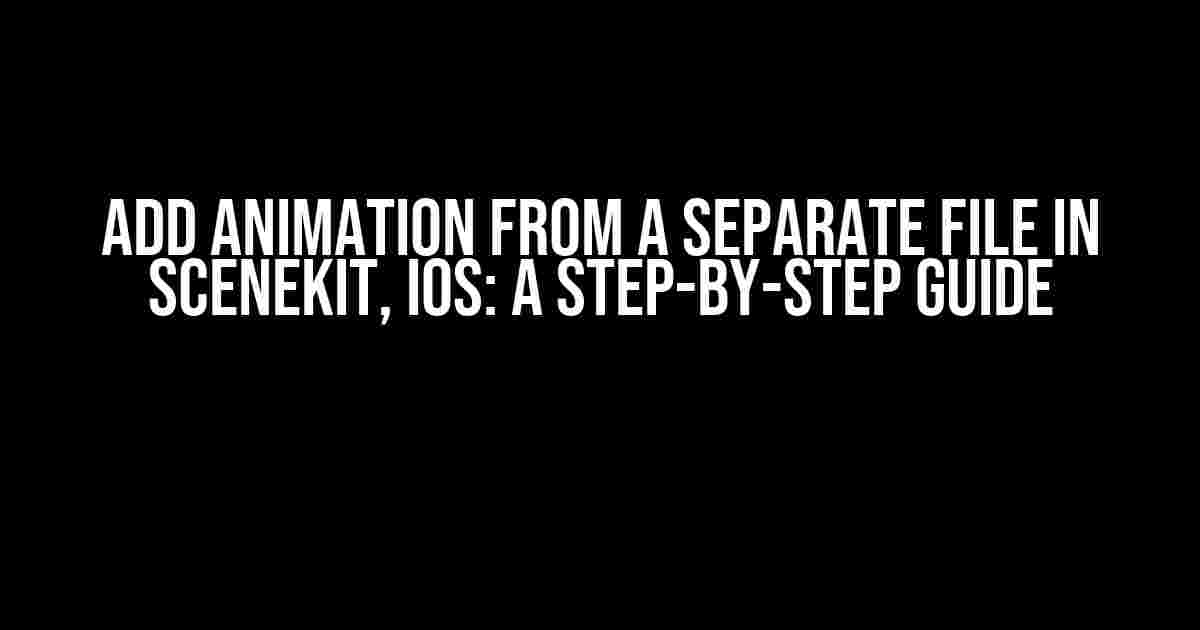Are you tired of cluttering your SceneKit projects with bulky animation code? Do you want to separate your animations from your main scene and load them dynamically? Look no further! In this article, we’ll explore how to add animations from a separate file in SceneKit, iOS, and take your 3D rendering skills to the next level.
Why Separate Animation Files?
Separating your animations from your main scene has several benefits:
- Code organization**: Keep your project organized by separating concerns and reducing clutter.
- Reusability**: Load and reuse animations across multiple scenes, reducing code duplication.
- Modularity**: Easily swap out animations or update them without modifying your main scene code.
Preparing Your Animation File
Before we dive into loading animations from a separate file, let’s create an animation to load. Create a new Swift file in your project, e.g., `AnimationLoader.swift`. This file will contain the animation data and loading logic.
import SceneKit
class AnimationLoader {
// Animation data
var animations: [SCNAnimation] = []
// Load animation from file
func loadAnimation(from file: String) {
// TO DO: Load animation data from file
}
}
Loading Animation Data from a File
In this example, we’ll use a simple JSON file to store our animation data. Create a new file, e.g., `animations.json`, and add the following data:
{
"animations": [
{
"name": "spin",
"duration": 5.0,
"keys": [
{
"time": 0.0,
"transform": "Rotate 0 1 0 0"
},
{
"time": 5.0,
"transform": "Rotate 0 1 0 180"
}
]
},
{
"name": "bounce",
"duration": 2.0,
"keys": [
{
"time": 0.0,
"transform": "Translate 0 0 0"
},
{
"time": 1.0,
"transform": "Translate 0 2 0"
},
{
"time": 2.0,
"transform": "Translate 0 0 0"
}
]
}
]
}
In your `AnimationLoader` class, add the following code to load the animation data from the JSON file:
func loadAnimations(from file: String) {
// Load JSON data from file
if let jsonData = try? Data(contentsOf: URL(fileURLWithPath: file)) {
do {
let json = try JSONSerialization.jsonObject(with: jsonData, options: [])
if let animationData = json as? [String: Any] {
// Extract animation data
if let animationsArray = animationData["animations"] as? [[String: Any]] {
for animationData in animationsArray {
let animation = SCNAnimation()
animation.name = animationData["name"] as? String
animation.duration = animationData["duration"] as? CGFloat ?? 0.0
animation.tracks = []
if let keys = animationData["keys"] as? [[String: Any]] {
for key in keys {
let timeStamp = key["time"] as? CGFloat ?? 0.0
let transform = key["transform"] as? String
let animationKey = SCNAnimationKey(time: Float(timeStamp), value: transform)
animation.tracks?.append(animationKey)
}
}
self.animations.append(animation)
}
}
}
} catch {
print("Error loading animation data: \(error)")
}
}
}
Loading Animations in Your Scene
Now that we have our animation data loaded, let’s create a new SceneKit scene and load the animations.
import SceneKit
class GameScene: SCNScene {
override init() {
super.init()
// Create animation loader
let animationLoader = AnimationLoader()
// Load animations from file
animationLoader.loadAnimations(from: "animations.json")
// Add animations to scene
for animation in animationLoader.animations {
self.rootNode.addAnimation(animation)
}
}
}
SceneKit Node Hierarchy
To play the animations, we need to add them to a SceneKit node. Let’s create a simple node hierarchy:
let node = SCNNode()
node.geometry = SCNSphere(radius: 1.0)
node.rotation = SCNVector4(x: 0, y: 1, z: 0, w: 0)
self.rootNode.addChildNode(node)
Now, let’s play the animations on our node:
for animation in animationLoader.animations {
node.addAnimation(animation, forKey: animation.name)
}
Troubleshooting and Tips
If you’re having trouble loading or playing animations, check the following:
- Ensure the animation file is in the correct location and named correctly.
- Verify the animation data is correctly formatted in the JSON file.
- Check the node hierarchy and animation assignment in your SceneKit scene.
Tips and variations:
- Load animations dynamically based on user input or game state.
- Use animation controllers to manage animation playback and blending.
- Experiment with different animation types, such as physics-based animations.
Conclusion
In this article, we’ve explored how to add animations from a separate file in SceneKit, iOS. By separating our animation data from our main scene code, we’ve achieved a more modular and reusable animation system. With this newfound knowledge, you can elevate your SceneKit projects to the next level and create engaging, interactive 3D experiences.
| Keyword | Summary |
|---|---|
| Add animation from a separate file in SceneKit, iOS | Loading animations from a separate file using JSON data and SceneKit’s animation API. |
Happy coding, and don’t forget to share your creations with the world!
Frequently Asked Question
Are you struggling to add animations from a separate file in SceneKit, iOS? Don’t worry, we’ve got you covered! Check out these frequently asked questions and their answers to get you started.
What file format should I use to add animations from a separate file in SceneKit, iOS?
You can use .dae (Collada) or .scn files to add animations from a separate file in SceneKit, iOS. These file formats are compatible with SceneKit and allow you to import 3D models and animations.
How do I load an animation from a .dae file in SceneKit, iOS?
You can load an animation from a .dae file in SceneKit, iOS by using the SCNSceneSource class. Create an instance of SCNSceneSource and load the .dae file using the `sceneSource:WithURL:options:` method. Then, retrieve the animation by accessing the `animations` property of the SCNScene instance.
Can I add animations to a SceneKit scene programmatically?
Yes, you can add animations to a SceneKit scene programmatically by creating a CAAnimation instance and adding it to the node’s `animations` dictionary. You can also use the `SCNAction` class to create an animation and run it on a node.
How do I trigger an animation from a separate file in SceneKit, iOS?
You can trigger an animation from a separate file in SceneKit, iOS by accessing the animation from the SCNScene instance and calling the `play()` method on the animation. You can also use the `run(_:)` method on the SCNNode instance to run the animation.
Can I modify an animation from a separate file in SceneKit, iOS?
Yes, you can modify an animation from a separate file in SceneKit, iOS by accessing the animation’s properties and modifying them. For example, you can change the animation’s duration, speed, or timing function.


